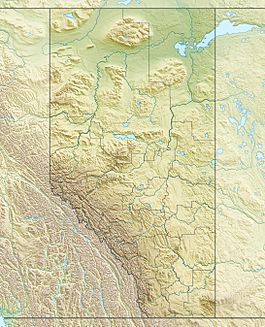Boom Mountain facts for kids
Quick facts for kids Boom Mountain |
|
|---|---|

Boom Mountain and Boom Lake
|
|
| Highest point | |
| Elevation | 2,758 m (9,049 ft) |
| Prominence | 442 m (1,450 ft) |
| Listing | Mountains of Alberta Mountains of British Columbia |
| Geography | |
| Location | Alberta and British Columbia, Canada |
| Parent range | Bow Range Canadian Rockies |
| Topo map | NTS 82N/08 |
| Geology | |
| Age of rock | Cambrian |
| Type of rock | Sedimentary rock |
| Climbing | |
| First ascent | 1903 Dominion Survey Party |
Boom Mountain is a cool mountain found in the Canadian Rockies. It sits right on the border between Alberta and British Columbia in Canada. This means it's also on the Continental Divide, which is like a giant line where rivers flow either east or west.
The mountain got its name in 1908 from a lake nearby called Boom Lake. An expedition from the Alpine Club of Canada saw a bunch of logs floating on the lake. They looked like a "log boom," which is a way to hold logs together in water. That's how the mountain got its unique name!
How Boom Mountain Was Formed (Geology)
Have you ever wondered how mountains are made? The rocks that make up Boom Mountain tell an amazing story!
Layers of Rock
Boom Mountain is mostly made of something called sedimentary rock. This type of rock forms over millions of years from layers of sand, mud, and tiny bits of shells that settle at the bottom of ancient seas. Imagine layers of dirt piling up, getting squished, and turning into solid rock!
Ancient Seas and Mountain Building
These sedimentary rocks were laid down a very, very long time ago, from the Precambrian period all the way to the Jurassic period. That's a huge span of time, even before dinosaurs roamed the Earth!
Later, during a time called the Laramide orogeny, massive forces deep inside the Earth pushed these rock layers. They were pushed east and even slid over younger rocks. This incredible squeezing and pushing is what lifted the land and created the towering peaks of the Canadian Rockies, including Boom Mountain.
Weather Around Boom Mountain (Climate)
The climate tells us what the usual weather is like in a place. Boom Mountain has a subarctic climate. This means it has very cold and snowy winters, but its summers are usually mild and pleasant.
Winter Wonderland
In winter, temperatures on Boom Mountain can drop really low, sometimes below -20 °C (that's -4 °F!). When the wind blows, it can feel even colder, with wind chill factors making it feel like -30 °C (-22 °F) or even colder. So, if you ever visit in winter, make sure to bundle up!
Summer Days
Even though winters are harsh, the summers offer a nice break. They are mild, which is perfect for exploring the beautiful nature around the mountain.



